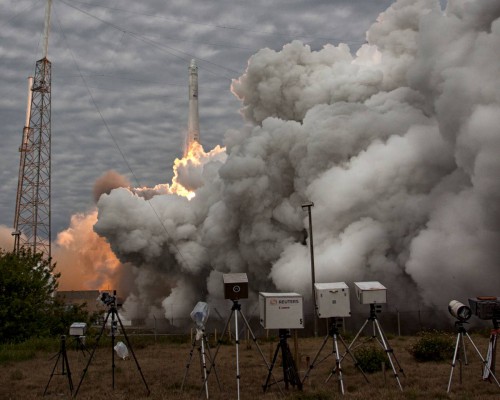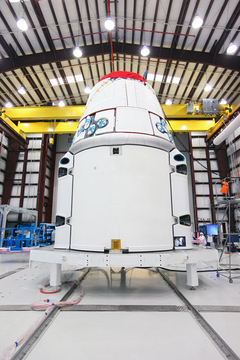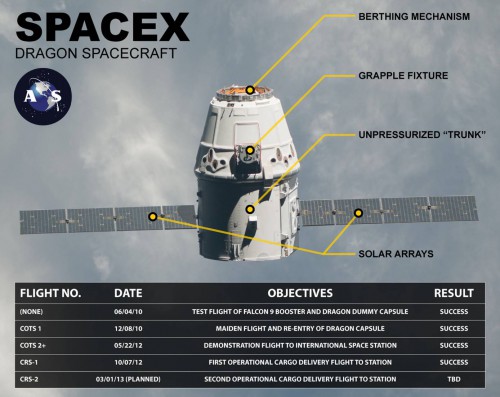
Following yesterday’s eventful launch, the second dedicated Dragon cargo ship has settled into orbit and is en-route to a docking with the International Space Station, after what SpaceX CEO Elon Musk described as a “frightening” first few hours. According to Expedition 34 crewman Chris Hadfield, who tweeted from the ISS earlier today, the Dragon’s early problems appear to now be “fixed” and the astronauts were in the process of “re-planning the rendezvous and grapple schedule” for the robotic visitor. Current thinking is that the spacecraft will arrive in the vicinity of the station tomorrow (Sunday) for capture by the 57-foot-long Canadarm2 robotic arm and berthing on the Earth-facing Harmony node.
The present CRS-2 mission—the third Dragon to visit the station and SpaceX’s second under its $1.6 billion Commercial Resupply Services contract with NASA—was launched in seemingly perfect fashion from Space Launch Complex (SLC)-40 at Cape Canaveral Air Force Station, Fla., at 10:10:13 a.m. EST, 1 March. Unlike last October’s CRS-1 launch anomaly, the nine Merlin-1C engines on the first stage of the Falcon 9 rocket appear to have performed well, as did the single Merlin-1C Vacuum engine on the second stage. However, shortly after the separation of the Dragon, the situation went distinctly awry.
Three of the four Draco thruster pods did not activate properly, due to a blockage in a propellant pressurization line. This threw out of sync several pre-programmed tasks, including the deployment of the solar arrays, and the scheduled 2 March ISS docking was scrubbed. Although two thrusters will suffice to get to the station, at least three are needed to satisfy NASA’s ISS Program that the Dragon is fully-controllable. There were other woes. If the thrusters could not be brought on-line, the cargo craft’s 120-mile perigee would be too low to enable it to remain in orbit for more than a couple of days.

At length, SpaceX engineers worked through the troubles, bringing all four Draco pods on-line, performing the critical orbit-raising maneuver, and re-establishing the snub-nosed spacecraft on course for the station. “Orbit raising burn successful,” Elon Musk tweeted yesterday, the excitement undeniable in his words. “Dragon back on track.”
By the time Chris Hadfield sent his own tweet today, the cargo ship—whose 1,490 pounds of payload is housed both in its pressurized cabin and, for the first time, in its large unpressurized “Trunk” section—was about 1,770 miles “ahead” of the ISS. From his perspective, Elon Musk described the event as “a glitch of some kind … not serious,” but nevertheless illustrative of the reality that launching spacecraft remains a business laden with risk. “There’s no leakage,” he acquiesced of the Draco propellant line trouble. “There’s no debris or fluid or gas leakage that we’re aware of. All systems seem to be intact and functioning quite well.”
If Dragon receives an all-clear to approach the ISS tomorrow, it will do so by adopting an “R-Bar” (or “Earth Radius Vector”) rendezvous profile. This follows an imaginary line, extending from the center of the Earth to the space station, meaning that the cargo craft will effectively rise to meet it from “below.” In doing so, Dragon will take advantage of natural gravitational forces to brake its final approach and limit the need for thruster firings.
As it draws closer to its target, the spacecraft will establish an ultra-high-frequency link using its UHF communications unit (CUCU), which enables the space station’s incumbent Expedition 34 crew—led by Commander Kevin Ford—to monitor the final approach. A carefully orchestrated symphony of maneuvers will bring the Dragon to a position about 1.5 miles from the ISS, where a “Go/No-Go” decision to proceed will be made. Further Go/No-Go decisions will be made at distances of 3,700 feet, then 820 feet, then 100 feet, and finally 30 feet, before Dragon is captured by U.S. Operating Segment (USOS) crewmen Ford and Tom Marshburn, using the Canadarm2. Both men will be based in the station’s multi-windowed cupola, which will afford them expansive panoramic views of the rendezvous and docking at the nadir-facing Harmony node.

During these incremental steps toward its quarry, Dragon will employ its close-range guidance instruments, including lidar and thermal imaging equipment, to confirm the accuracy of its position and velocity. After initial berthing at Harmony, the vestibule between the two spacecraft will be pressurized Sunday, and Ford and his crew will open the hatch to begin a three-week process of unloading Dragon’s cargo. A little more than half of the load is devoted to ongoing scientific research and includes a pair of GLACIER experiment refrigerators, a spare electronics unit for a MELFI freezer, a carbon dioxide removal assembly, and general crew provisions. Mounted on the unpressurized Trunk are two Heat Rejection Subsystem Grapple Fixtures (HRSGFs), which will be installed on the station’s truss during an EVA by astronauts Chris Cassidy and Luca Parmitano in July.
The remainder of the CRS-2 mission remains to be seen. The pre-launch press kit outlined a four-week voyage, with the pressurized capsule re-entering and splashing down, a few hundred miles off the coast of Southern California, 25 March. Such plans may require revision, based upon recent events. All in all, SpaceX’s CRS contract with NASA calls for 12 dedicated missions—of which this is the second—and requires the delivery of some 44,000 pounds of payload to the ISS.




It shows how robust the systems engineering is on the Dragon that they were able to fix the thruster system problem from the ground.
Matt,
Agreed, SpaceX continues to prove time & again – that they are not to be underestimated. I’m very harsh on companies that state that they will launch crew. But, it’s getting to the point that when SpaceX says they can do something – I believe them.
Sincerely, Jason Rhian – Editor, AmericaSpace
Any ideas what could have caused this “glich”…stusnix…cosmic radiation
HAL 9000 having a bad day…..gum?
Most certainly, should problems arise when our Orion/SLS is launched, the newspacers will be equally as magnan
imous, understanding, and supportive of NASA.
Karol,
Exactly. They’ve been vile, they’ve burned that bridge & shouldn’t expect us to feel sorry for them after they’ve acted so poorly for so long. I’ve stated for a while now that they need to be building not burning bridges. Haven’t seen too many bridges built – have seen a ton of smoke. The political winds are forever changing & the one thing I predicted correctly was that eventually the winds would change again & the stench from their behavior would turn people off of their products. Of course, they’ll act like they’ve never done anything to deserve having the tap cut off, but for those of us who have had to tolerate their antics & have watched as the current administration stacked the deck in their favor – we know better.
Sincerely, Jason Rhian – Editor, AmericaSpace
Did you hear that Senators Shelby, Nelson, and Mikulski? Did you hear Representatives Wolf, Smith, and Rohrabacher? That was the sound of INTEGRITY, INTELLECTUAL HONESTY, and COURAGE!! That was the voice of many, many of us in the space community who have been shouted down into a silent simmering “political correctness”. If only we had HIS voice in Congress. What he has spoken has been proven true time and again, and he is not afraid to speak truth to power. As lawmakers, you determine the fate of our space program. Jason Rihan speaks for US!!! LISTEN TO HIM!!